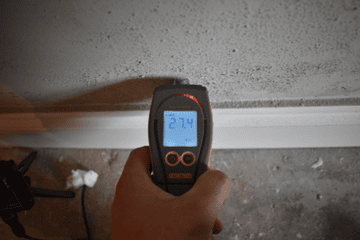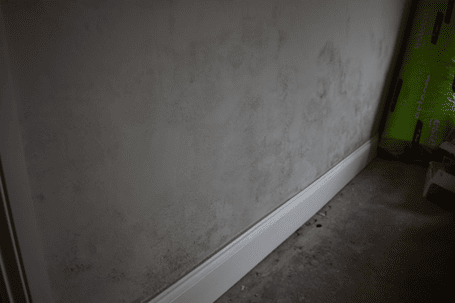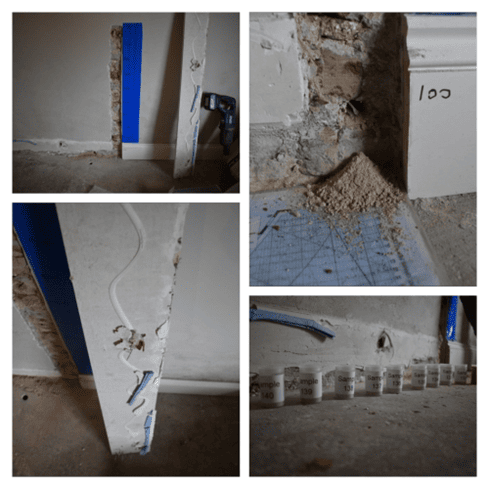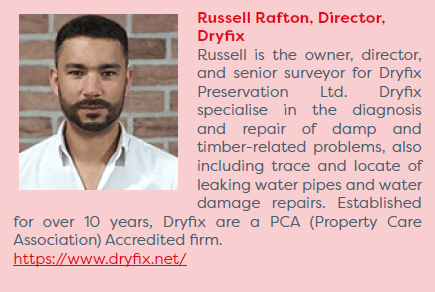The Great Damp Illusion.

In this article, Russell Rafton provides a case study that demonstrates why moisture meters shouldn’t be relied upon alone when inspecting property and assessing the levels of moisture in walls.
Surveying properties for damp related problems is a far more complicated subject than many appreciate and that’s probably due to the huge variety of potential causes, the complex routes that water/moisture takes through a building, and potential masking effects. There’s no doubt that buildings are complex and rarely are two ever the same. Construction practices have evolved over time, as well as the materials we choose to build with. Most people would look at a wall and consider it just a wall, however, when you break it down it’s far more than just a wall, it’s a foundation, a damp proof course, facing bricks, mortar, plaster, paint and skirtings. They all have different relationships to the surrounding structure and they’re all materials that react differently to moisture.
Every good building surveyor should have a decent understanding of material science and the various construction methods both above and below ground level. The role of most building surveyors is generally observational, however in our industry, diagnosis is very rarely provided through observation alone. Very little can be understood from just observing the surface of a wall and accurate diagnosis generally requires some investigative work and testing of materials for moisture and contamination. The problem is that many of the instruments we use for assessing damp are not always fit for purpose; they can be very misleading and difficult to interpret.
Over the years I’ve read many building reports which include disclaimers such as “Dear Mrs Smith, thank you for inviting me to survey your property for damp. During your survey, I used an electronic moisture meter which when used on masonry takes readings which aren’t quantitive, therefore, it cannot accurately measure damp in walls. My assessment is therefore merely an interpretation of instrumental readings and visual observations made during the survey”.
If a client is paying you to investigate a potential damp problem, then surely for it to be accurate this should be conducted quantitively? (Although I appreciate that for a purchaser the inspection and report usually has to be done quickly as part of the property transfer process and often there is not the luxury of time to do a full quantitative investigation)
I often read people’s comments online on how finding rising damp is rare and how establishing the root cause is so important to provide accurate diagnosis, but in reality, most diagnoses are made via the interpretation of an electronic moisture meter. So just how accurate are they?
This case study demonstrates just how easily electronic moisture meters can be misinterpreted, even when combined with what most would consider clear and obvious symptoms of rising damp. Ask yourself, in this situation, how accurate do you think your diagnosis would be?
The Property
Our client purchased a period farmhouse on the outskirts of York which required extensive refurbishment.

Figure 1: Front and side elevation of property
They employed a trusted family friend and local interior designer to assist with the refurbishment and help recruit a team of contractors to undertake the work. In addition to the refurbishment, a new extension was constructed. As part of the renovation works the building contractor installed a new damp proof course and re-plastered the entire property with what the client believed to be a lime plaster. Shortly after completion, however, the property started to display symptoms of a developing problem. The recently finished interior decorations started to spoil as the paintwork blemished and flaked from the ground up – see image below.

Figure 2: Distressed internal decorations which started to spoil shortly after the renovation was completed
Naturally, this caused a lot of heartache and distress for the homeowners. The immediate concerns were towards the builder, the person responsible for the renovation and damp proof course installation, however, they discovered the builder wasn’t a damp specialist and there was no paper trail of an initial damp assessment, no written specification and of course, no guarantee.
The client did what most homeowners would do in this situation, and they brought in a specialist to assess the building and provide a diagnosis. The specialist’s survey, as is all too often the case, was conducted in a non-destructive manner, merely a visual inspection and appraisal of the property’s condition interpreted by readings taken from the walls with an electronic moisture meter. The results of their investigation disclosed that the property was suffering with rising damp due to poor building practices during the renovation.
Visually you’d be forgiven for coming to this conclusion because there’s evidence of distress to the internal decorations which appears to be migrating from the ground, symptoms you’d normally associate with rising damp. The electronic moisture meter when used in this region also screams aloud, alluding to the likelihood of moisture within the plaster and a problem with rising damp. But on its own and particularly from a specialist’s standpoint, is this evidence sufficient to diagnose rising damp, particularly when there’s a likelihood of future litigation?

Figure 3: Electronic moisture meter revealing high readings when the spoiling plaster is tested
If you’ve ever wanted to know just how accurate electronic moisture meters can be at interpreting damp profiles, you may find this article useful. When compared to disruptive gravimetric sampling, electronic moisture meters are highly accurate, however, they can be misinterpreted even when all the symptoms suggest they are right.
We were contracted to undertake an intrusive survey to investigate the apparent claims and to accurately establish the condition of the walls. The British Research Establishment (BRE) guidance document 245 “Rising damp in walls – Diagnosis and Treatment” suggests that whilst electrical moisture meters do have a valuable role to play as preliminary surveying instruments, to obtain conclusive proof regarding the condition of the wall the most satisfactory approach is to take samples of masonry and plaster for analysis. As such, in addition to our general survey, I was granted permission to extract samples of masonry from the problematic walls for moisture and contamination analysis.
In addition to our visual inspection of the property both externally and internally, skirting boards were removed from the most problematic walls, plaster was removed vertically exposing the brickwork and mortar joints, and samples were methodically removed from the walls. These samples were then removed from site and processed over the following days in our in-house laboratory using the gravimetric process breaking down the sum components of each samples’ total moisture content. Each sample was then tested for mineral salt contamination.
For those interested, this article explains the process of methodically extracting samples for analysis whether that be onsite analysis using a speedy/carbide meter or offsite laboratory analysis.

Figure 4: Samples extracted from the problematic walls for offsite moisture and salt analysis
The results of our lab analysis revealed that despite the wall’s visual appearance, the reaction of an electronic moisture meter and the prior diagnosis, these walls were in fact dry. Moreover, the walls weren’t just dry, they were bone dry with moisture levels that varied between only 0-1.1% free moisture content. This was a very dry building.
The distress caused to the plaster was the result of hygroscopic contamination and efflorescent surface salting. Our analysis revealed low but traceable levels of chloride salts in the samples, but high levels of groundwater nitrate salts were deposited throughout the walls. Hygroscopic contamination is, in theory, a form of dampness, however, the moisture present isn’t the result of groundwater or penetrating damp, but from moisture within the air which is attracted to the surface of the wall due to contamination. Whilst hygroscopic contamination is clearly damaging to the plaster and internal decorations, there’s very little risk of decay or severe damage to the structure as would normally be associated with other forms of dampness.

Key
TMC = Total Moisture Content
HMC = Hygroscopic Moisture Content
FMC = Free Moisture Content
Figure 5: Laboratory results from one profile taken within the building highlighting the absence of free moisture within the walls.
It’s clear that at some point throughout the building’s history, this property has been affected by moisture from the ground, hence the deposits of nitrate salts, however, the cause has clearly subsided. This doesn’t necessarily mean that an effective damp proof course was installed by the builder, in fact, quite the opposite. The reality is the cause is more likely to be the result of an escape of water such as a burst water service or failed drain historically that’s been attended to.
In addition to the above, despite understanding the walls had been plastered with lime, upon further investigation, we discovered that they hadn’t. In fact, the walls had been plastered with a combination of modern cement-based renovating plasters and some gypsum materials. Unfortunately, the renovating plaster used is notorious for salting after application as the water mixed within the plaster starts to leave the surface of the wall. As such, there is a likelihood that distress to the decorations had also been attributed to early redecoration before the plaster fully dried after application. The gypsum plasters simply should never have been used.

Figure 6: Inappropriate use of gypsum and cement renovating plasters during refurbishment
Unfortunately for the client, the likelihood is the spoilt plaster and decorations will probably need to be replaced, however, a replacement damp proof course isn’t necessary, saving a considerable expense. Furthermore, they no longer have the worry that their property is rapidly deteriorating due to damp.
The next time you’re on a survey and your electronic moisture meter starts screaming, just remember in reality that damp meters are best used to disclose when a material is dry rather than when it is damp. Therefore, my advice is, whenever there is ambiguity, I’d always recommend you advise an intrusive survey with quantitive analysis from a credible contractor.
